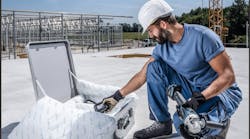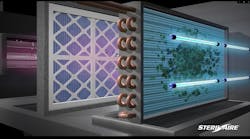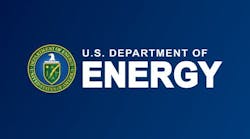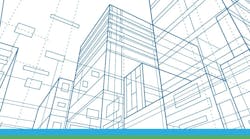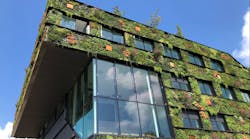By SAM BOWMAN
With climate change continuing to accelerate, it's becoming even more crucial to embrace eco-friendly practices in every aspect of our lives. And when it comes to HVAC, sustainability has shown significant progress. Green HVAC design provides various solutions for environmentally friendly building systems, from cutting carbon footprints to saving on energy bills.
This article will explore the benefits of eco-friendly processes and highlight the innovative technologies and practices that contribute to a more cost-efficient ecosystem.
Why Choose Green Design?
Green HVAC design incorporates sustainable practices and technologies into heating, ventilation, and air conditioning systems. The goal is to lower the negative impact on the environment while maximizing efficiency.
One of the main reasons for choosing sustainable HVAC design is its long-term savings. Although the upfront installation costs might be higher than traditional HVAC, it will still be able to offset the rising energy bills that many residents are facing. Furthermore, since green HVAC systems use renewable energy sources such as biodiesel, they’re able to create a positive impact that will help reduce users’ carbon footprint.
Softening Weather's Impact on Health
Varying weather conditions can significantly influence people's health, especially those who are more vulnerable, such as children, older people, and those with chronic conditions. Sustainable HVAC design helps mitigate these effects by:
- Improving indoor air quality: Advanced filtration system remove allergens, pollutants, and other harmful particles from the air. This reduces the risk of respiratory illnesses and promotes better overall health;
- Regulating temperature and humidity levels: Extreme temperatures can lead to heat exhaustion or hypothermia. Green HVAC devices can effectively regulate temperature and humidity levels, ensuring occupants have a comfortable and safe indoor environment.
With these features, green HVAC systems contribute to better surroundings and improve the overall well-being of individuals.
Tax Incentives for Green Practices
Many governments and organizations offer tax incentives to encourage adopting sustainable practices, including green HVAC systems. These incentives can include:
- Rebates or tax credits for the installation of energy-efficient equipment;
- Reduced property taxes for buildings that meet sustainable building standards;
- Tax deductions for using renewable energy sources.
These incentives not only make it more affordable to install green structures, but they also help promote sustainable practices and contribute to a brighter future.
Benefits of Geothermal Heating and Cooling
Geothermal heating and cooling systems are some of the most popular sustainable solutions in green HVAC design. Let's take a closer look at the benefits of this innovative technology:
- Energy efficiency: Geothermal systems use the Earth's natural heat to regulate indoor temperatures, significantly lessening energy consumption;
- Cost savings: The high energy efficiency from these systems can lower energy consumption by up to 72%, translating to lower energy bills;
- Environmentally friendly: This process produces zero carbon emissions and does not rely on fossil fuels, making it a sustainable and eco-friendly option for heating and cooling needs;
- Durability and low maintenance: Geothermal systems have fewer moving parts, resulting in lower maintenance costs. They also have a longer lifespan compared to traditional systems, making them a more affordable solution in the long run.
These geothermal systems can also help increase building efficiency by creating stable indoor temperatures and reducing the overall environmental impact.
Innovative Tech in Green HVAC
Advancements in technology have led to the development of new and improved systems that contribute to a greener and more efficient process. Some of these include:
- Energy-recovery-ventilation (ERV) system: This uses a heat exchanger to capture and transfer heat from warm areas of the building to cooler ones, minimizing energy waste and further reducing energy costs by up to 70%;
- Geothermal pumps: These innovative pumps are able to transfer heat from the ground to heat buildings during the winter, while also extracting heat during the summer for a cooler atmosphere;
- Hydronic radiant floor heating: This technology uses pipes under the floor to circulate warm water, providing uniform and efficient heating;
- Quiet-duct wrap: This insulation material reduces noise levels and improves allergen filtration, promoting a healthier and more comfortable indoor environment;
- Smart technology in home systems: With the rise of smart homes, HVAC procedures have also become smarter and more energy-efficient. Sensors and smart thermostats can adjust temperature settings based on occupancy levels and optimize energy usage;
- Wireless technologies: Automation and wireless control are becoming increasingly common in green HVAC devices. These technologies allow for easy control and monitoring of temperature, humidity, and ventilation levels, resulting in energy efficiency and cost savings.
With the increasing demand for sustainable practices, we can expect to see more incredible developments in this area. It is truly a field that keeps evolving, making it an exciting time for professionals and building owners looking to positively impact the environment while also enjoying the savings.
Overall, green HVAC design provides a range of sustainable solutions for building systems. These advancements, from geothermal heating and cooling to tech such as wireless control, help create more efficient conditions. With the added benefit of affordability and increased comfort, it is clear that the future of HVAC structures lies in sustainability.
##########
Sam Bowman writes about people, tech, workers, and how they merge. He enjoys getting to utilize the internet for the community without actually having to leave his house. In his spare time, Bowman likes running, reading, and combining the two in a run to his local bookstore. Email: [email protected].




